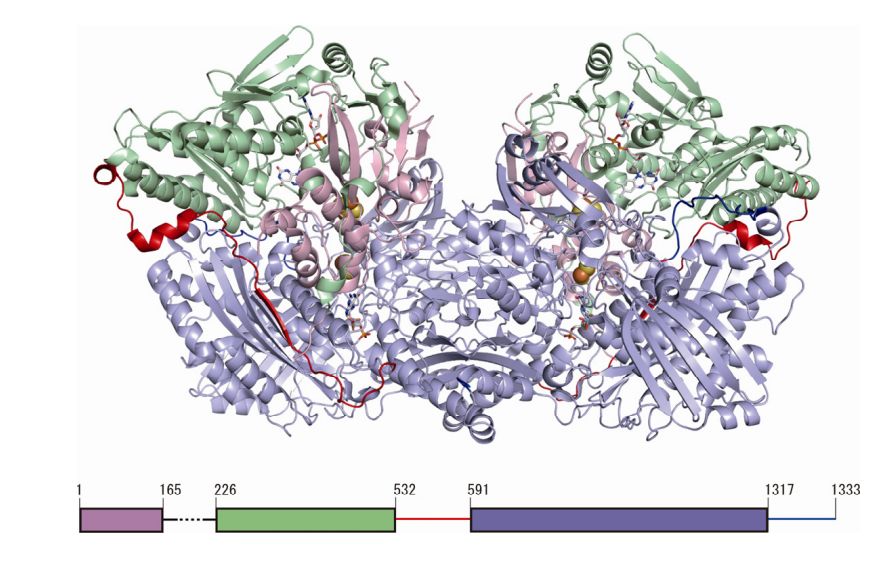As a world-leading service provider of antibody development and generation, Creative Biolabs is ready to provide a whole series of biomarker-specific in vitro diagnostic (IVD) antibody development services. A team of experienced scientists focused on antibody development are pleased to assist you in your project in a timely and cost-effective manner. Here, we introduce our IVD antibody development services targeting xanthine oxidase marker.
Introduction of Xanthine Oxidase
Xanthine oxidase (XO) is a monomolecular homodimeric enzyme of 270 kDa and a potential source of reactive oxygen species (ROS) in vascular disease. It is generated from the xanthine oxidoreductase via proteolysis and encoded by the chromosome 2p23.1. XO belongs to a member of the molybdenum-protein family which contains a molybdenum (Mo) atom, one of the flavin adenine dinucleotides (FAD), as well as two iron-sulfur (2Fe-2S) centers of the ferredoxin in each of its two subunits. In humans, this enzyme is found in the parenchyma and bile duct epithelial cells of the liver and epithelial cells of the intestine, also reported in the neutrophils.
 Fig.1 Structure of human XOR.1, 3
Fig.1 Structure of human XOR.1, 3
XO has two separated substrate-binding sites and involved in purine catabolism of some species, including humans. It can catalyze the oxidation of hypoxanthine to xanthine, this process that generates ROS (e.g. superoxide radicals (O2-) and hydrogen peroxide (H2O2) because XO easily donates electrons to oxygen molecules. And xanthine is further catalyzed by XO to the uric acid, which is excreted by kidneys. Excessive amounts and inadequate excretions of uric acid will result in hyperuricemia. Moreover, high levels of XO are synonymous with some inflammatory diseases, where it elicits a pathogenic role.
Sepsis and XO
Sepsis and related syndromes, as the multi-system organ dysfunction, are the most major causes of morbidity and mortality in patients of intensive care units (ICU). There is potent evidence of severe oxidative stress in sepsis illness. Under normal circumstances, a balance exists between oxidant and antioxidant defenses. Oxidative stress occurs when this balance is hurt by excessive productions of ROS or inadequate antioxidant defenses. Both mechanisms may participate in the sepsis.
 Fig.2 Sepsis induces oxidative stress and disseminates intravascular coagulation.2, 3
Fig.2 Sepsis induces oxidative stress and disseminates intravascular coagulation.2, 3
Sepsis is a complex syndrome featured by a broken balance between pro-inflammatory and anti-inflammatory response to pathogens. Some hypothetic molecular mechanisms of sepsis and its progression are associated with the imbalance between ROS production and its degradation through cellular antioxidant pathways, and this unbalance has provided clues to design new treatment ways. Studies showed the appearance of XO activity in the human plasma of septic patients. XO as a dehydrogenase can oxidize purines, pyrimidines, pteridines, and other heterocyclic nitrogenous compounds. In mammal organisms, this enzyme is converted from the nicotinamide-adenine dinucleotide-dependent xanthine dehydrogenase into the oxygen-dependent oxidase, either by reversible sulfhydryl oxidation or irreversible proteolytic modification. Ischemia leads to cellular depletion of adenosine triphosphate (ATP) with the accumulation of hypoxanthine and xanthine, both are substrates for XO. With the restoration of oxygen supply on reperfusion, the purines are converted to uric acid via XO and concomitant generation of superoxide radical anions.
IVD antibodies are extensively used for disease screening, prognosis, and therapeutic monitoring. With our versatile IVD platform, Creative Biolabs is proud to develop novel XO-specific antibody from scratch to commercial IVD kit (we can also start with provided antibody candidates). If you are interested in our service, please do not hesitate to contact us for more details.
References
- Ichida, Kimiyoshi, et al. "Mutations associated with functional disorder of xanthine oxidoreductase and hereditary xanthinuria in humans." International journal of molecular sciences 13.11 (2012): 15475-15495.
- Lopes-Pires, Maria Elisa, Jéssica Oliveira Frade-Guanaes, and Gregory J. Quinlan. "Clotting dysfunction in sepsis: a role for ROS and potential for therapeutic intervention." Antioxidants 11.1 (2021): 88.
- Under Open Access license CC BY 4.0, without modification.
For Research Use Only.

